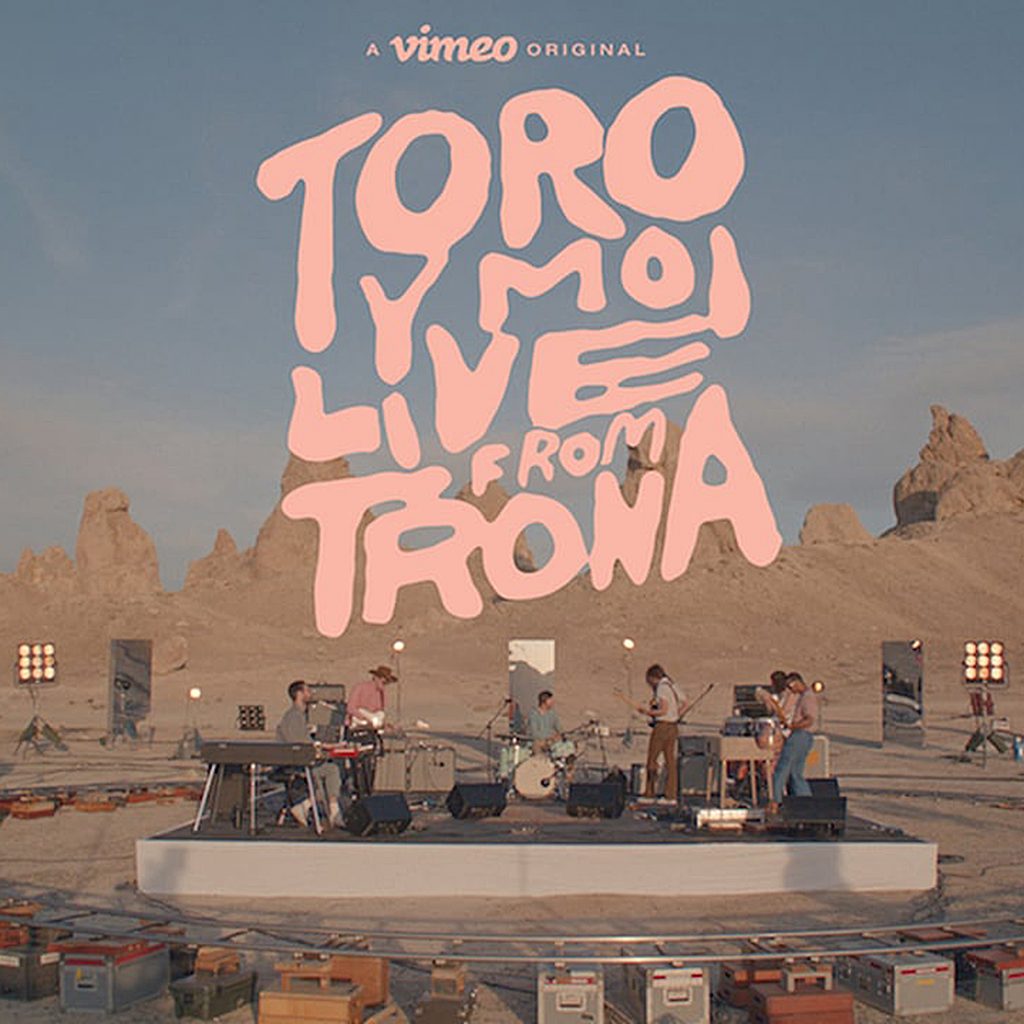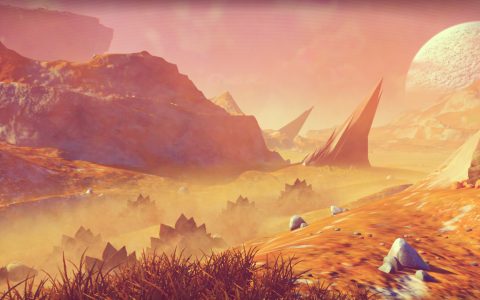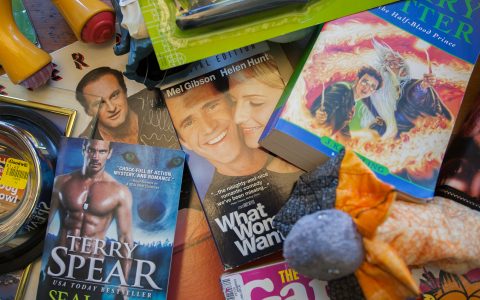Last spring, Chaz Bundick ventured out to the middle of the Mojave Desert to be reborn. But first, he went to the barber.
“I’m glad I got to do it with my head shaved,” he says. “Kind of like a nice reincarnation-type symbolism there.”
Bundick, also known as artist Toro Y Moi, was not on some acid-fueled spirit quest; rather, he cropped his trademark frizz and drove deep into the California wilderness to record his first live record, Toro Y Moi: Live From Trona, which was released in August. The album, filmed against a backdrop of red rock and a light pollution-free starry sky, is not only significant for its makeup—a concept inspired by Pink Floyd’s 1972 Live At Pompeii record, Bundick says—but also because it’s the last project he recorded while living in California.
Right around its creation, he headed north to the grayer skies of Portland, Ore., leaving behind the state that palpably inspired much of his most beloved work, from the video for “Say That” (filmed in the remote hills surrounding the Bay Area) to “Half Dome,” a song off his last record What For? named after the Yosemite rock formation. Trona serves as a tribute to the place that Bundick, a South Carolina native, never stopped exploring since moving there in 2013. “There’s just a super need to keep searching…. [the album] was a nice farewell.”
Chaz Bundick (Toro Y Moi)
Of course, Bundick keeps the nostalgia brief; as one could predict from his catalogue, which has covered plenty of sonic ground since its inception during the “chillwave” craze, he’s already onto something new. Seemingly nothing he does, whether it’s the four-to-the-floor rhythms of his 2014 dance record Les Sins or the sunny acid rock of What For?, is based in repetition. With that said, at the moment, his creative endeavors are decidedly more withdrawn. Rather than devote time to a new solo project, he’s spent his first few months in Oregon producing records for other bands on Carpark Records.
Typically, the artists will fly to his new house in Southeast Portland, crash on his couch and record on makeshift mics in his bedroom, he says. In between recording, he likes to draw and paint, mediums that he’s long had a passion for but can now be pursued more seriously now that he has enough space for an art studio. All this is sprinkled with walks through the city’s lush nature ways, including Sauvies Island, a mass of farmland on the Columbia River that is a go-to swimming spot for locals during the summer and somewhere he’s headed to right after we get off the phone, he tells me.
Drew Stewart Photography / Flickr Creative Commons
This low-key lifestyle may seem a little strange for someone who plays sold-out shows across the country and been known to hang with colorful hip-hop figures like Tyler, the Creator and Diddy. But if you’ve ever watched an interview with Bundick, the mellowness of it fits; he speaks with an earnest, gentle tone and has never made a point of putting his persona first. Instead, it’s about satisfying a relentless artistic curiosity. “I like to work hard and be humble. I try to practice balance.”
That balance applies to all aspects of his life, including his consumption, which is usually limited to a half a joint in the morning or evening, he says. He treats it like coffee—a nice ritual that can help start or end the day. It helps round out a nice picture: An acclaimed indie musician moves to the quiet Northwest to get away from the noise and balance his time with painting, producing and the occasional toke.
But this lifestyle also can come with drawbacks; as we talk, Bundick mentions that he’s fairly isolated, not going out much and spending most of his social time speaking with friends back in California on the phone. Isolation, infamously demonstrated by artists like Bon Iver, can lead to breakthroughs, but can also be wearing—a risk Bundick is fully aware of.
“It’s fun to get a glimpse of that [glamorous] world,” he says, “but I don’t really want to be living that lifestyle.”
Reed Jackson (Leafly): The footage from Trona looks amazing, but you were still recording out in the middle of nowhere. Was that a pain in the ass at all?
Chaz Bundick (Toro Y Moi): The actual shoot had to be pushed back because there was a windstorm, so that kind of sucked. I don’t think we got charged extra for stuff but you know we had to rearrange flights and all that. It was really not the best scenario. I noticed the only thing I could hear were airplanes, and they were actually really loud. It sounded as loud as if you were in a neighborhood. It was weird. It felt like the weirdest band practice ever. We were just playing for each other essentially, and we would look at each other after the songs were over and agree on whether we were [satisfied] or not.
RJ: Was the concept inspired by any live albums of the past?
CB: It’s a total homage to Pink Floyd’s Live at Pompeii. Hands down that’s what the reference is. I think what we took from that is the band members were recording in a unique location and made an album of the audio. It was known that we were going into it to make a record.
RJ: None of your albums really sound alike, so I thought this was kind of a continuation of that—to keep doing something different.
CB: Yeah. In a way. I find it funny I now have a six-piece live band and people still call it electronic music, but it’s OK. I like pushing the boundaries of the electronic world.
RJ: Do you find it frustrating at all that people keep putting you in that box?
CB: No, not at all. I’m not really opposed to going back to the early stuff or anything. I’m just still exploring. The album just before [this] was electronic and after that I did Les Sins, and that was electronic. I’m always just exploring different worlds at different times. As of right now, I can see something even more electronic and maybe trying to see how I could do that live, but I have no idea how I’d do that yet.
Chaz Bundick (Toro Y Moi)
RJ: You’ve referenced the California countryside quite a bit in your music since you moved there. How important is nature to your creative process?
CB: California, out of all the states, is so amazing; the nature there is just jaw dropping. I’m glad that we picked Trona because it’s California, and it’s a symbolic state in general. There’s just a super need to explore and constantly keep searching.
It was recorded after [I moved to Portland]. I moved here and then three weeks later I flew down there. I wanted to find somewhere I could buy a home, and this was somewhere I could afford.
RJ: In Portland??
CB: Compared to the Bay? Yeah!
RJ: I’m from there, and compared to when I was a kid, housing prices seem pretty ridiculous right now.
CB: I know, yeah. But the thing is, where else could you go on the West Coast and it’s not California and not crazy [expensive]? I’m really attracted to the West Coast still. So yeah, when I talk about the nature, I’m talking about the nature of the West Coast in general—not just California.

RJ: Was Trona a goodbye to California?
CB: It was definitely a goodbye. It was a nice farewell. I’m glad I got to film it with my head shaved (laughs). Kind of like a nice reincarnation-type symbolism there. The timing just worked out for everything.
RJ: What have you been up to during your first few months in Oregon?
CB: I’m at Carpark Records now, so I’m just focusing a lot on recording the bands we’re working with for their releases. Pretty much just producing a lot of bands right now and just focusing more on my visual art type stuff. I’ve just been painting and drawing a lot more than I was. It’s a nice way to sort of take a break from music. It’s something that’s new to me and it’s just a great outlet for using my brain to work differently. It’s kind of interesting to see how my brain thinks for visuals versus music.
RJ: How have you noticed your brain working differently?
CB: There’s not really a difference in the mindset; really it’s more just in the process. With recording I’ll tend to delete more things and start over and over. But usually with painting, I’ll usually just leave what’s already there, whether it’s just changing the whole thing or painting over a little of it. I try to keep a little of each stage present so the build is a little more dynamic instead of just going into it like, “I’m going to use these three colors and these three shapes.” I just let it happen.
RJ: It’s interesting that you balance this laidback lifestyle with doing things like recording with Travis Scott and hanging with Tyler, the Creator.
CB: Yeah it’s kind of crazy that I have a whole life like that. I’m not that attracted to the glamorous aspect of being a popular musician. It’s fun to get a glimpse of that world, but I don’t really want to be living that lifestyle.. Yeah, I like to work hard and get nice things to an extent. I just like to work hard and keep it humble. I try to practice balance.
I just wake up everyday and take my dog out, sometimes get the paper. I don’t really have a crazy social life. I’ll go out or something and see some friends, but for the most part I like to hunker down and work on stuff. I talk to a lot of friends on the phone, really — Facetime people and catch up and talk ideas. The whole band is actually in L.A. and in the Bay, but I’m actually there quite often.
RJ: Portland is kind of famous for its marijuana. Have your smoking habits changed at all since moving there?
CB: Especially since I’m in Oregon, I like to listen to music definitely after smoking. You think differently about it; you listen more for the space than the actual notes. However you can, you start seeing patterns in music and start listening for all different things. When I make music, I’ll have a joint or something at the end of the day and listen to what I’ve been working on. See things from both sides.
I like to use it as much as I drink a cup of coffee. I enjoy it and it’s a ritual, but I don’t use it as a crutch. I’m not high all day. I like to have a cup of coffee, have half a joint and then maybe later in the day do it one more time.
RJ: Do you have a favorite strain?
CB: I recently got into the more CBD heavy [stuff]. The non-psycho active aspects of it really are awesome, especially if you travel as much as me. I fly all the time. It’s really nice. I don’t have to worry about getting crazy stoned.


